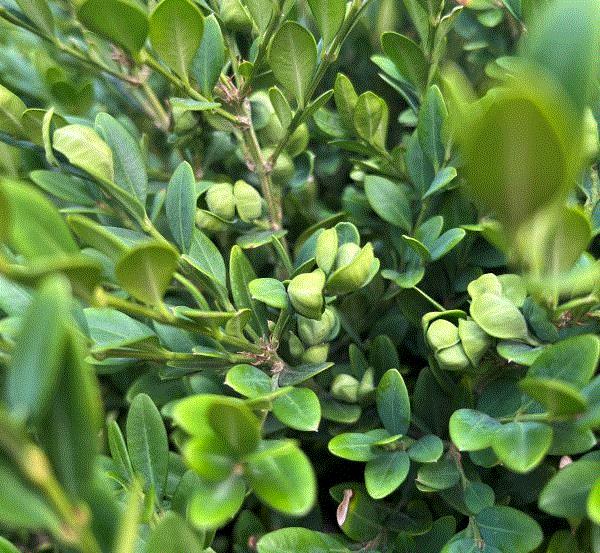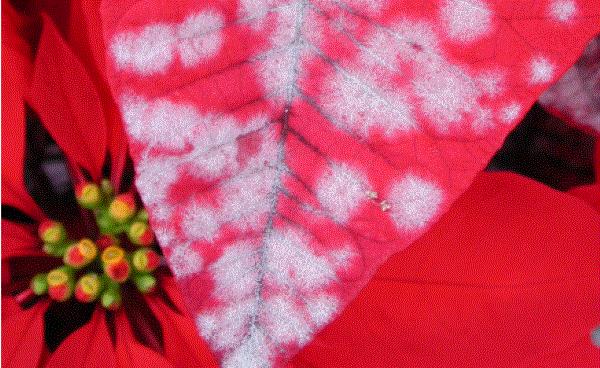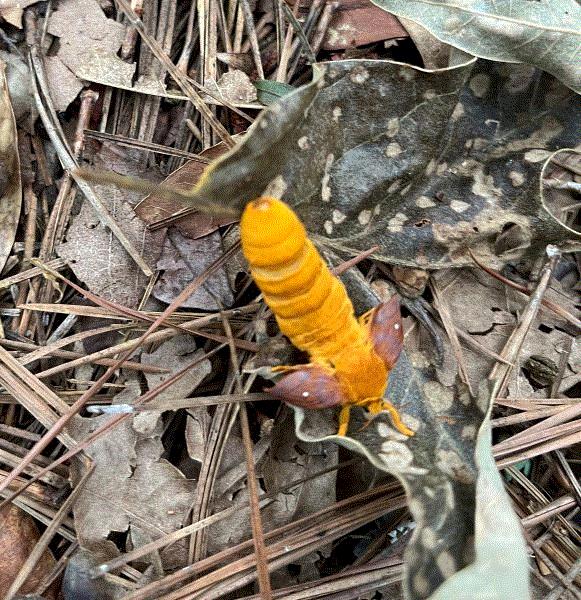What the ... ?
Glad to see some of you at Cultivate’23. This is my first Cultivate as an employee of SePRO instead of being a university researcher. I spent more time at the same booth, for obvious reasons, than I had in the past. Different feel, but still fun, nonetheless. The greatest gain I had from the show was to have some of you, my dear readers, seek me out! Thank you!
I found a hedge of boxwood across the street from the Nationwide Arena on my way back from dinner one evening. Some of the terminals had leaves that had grown into cups. I can tell you it’s a bug, not a disease, that causes this distortion. What’s the culprit?

Box Tree Moth Moves Into Ohio
Another boxwood pest is making the news. USDA-APHIS announced that box tree moth had been found and confirmed in Hamilton County, Ohio, in June. (I had to Google and see where Hamilton County is. Turns out the county seat is Cincinnati, where I drove through on my way to Cultivate.) Ohio is the third state where the box tree moth has been confirmed, following New York in 2021 and Michigan in 2022.
As far as I know USDA-APHIS hasn’t issued a response to the detection of box tree moth in Ohio. Federal orders were issued to prohibit movement of boxwood from several counties in New York and Michigan after the detections in these states. I expect the Ohio Department of Agriculture and APHIS to issue a similar prohibition or quarantine in the coming weeks.
The detection in Ohio is another example of educated citizens in action. A local resident took and submitted a photo of what was suspected to be a box tree moth to USDA in early June. APHIS and the Ohio Department of Agriculture conducted trapping in the area and caught two specimens. The specimens were subsequently confirmed as box tree moths. So be vigilant on major invasive pests and report any sightings! Click HERE to find information on how you can help find and report box tree moth in your neck of the woods.
Click HERE for USDA’s announcement of the detection in Ohio, and quarantine information in New York and Michigan. Also, click HERE for a collection of resources on identifying and managing the box tree moth.

Powdery Mildew on Poinsettia
Y’all started your poinsettia crop yet? Some growers in the South are already deep into it. Growers elsewhere have perhaps just started the crop. Regardless of where you are with the crop this year, watch out for powdery mildew on hot, humid days.
Nora Caitlin of Cornell Extension contributed a timely article on powdery mildew on poinsettia in this week’s e-GRO Alert. The white powdery patches on poinsettia leaves and bracts aren’t difficult to identify, but I didn’t know that the early symptom only shows up as chlorotic spots on the upper leaf surface. You’ll have to turn over the leaves to find the powdery patch on the underside.

Powdery mildew on a poinsettia bract. (Photo credit: Margery Daughtrey, Cornell Extension.)
I talked about powdery mildew on crapemyrtles in the last issue of this newsletter and I mentioned that I don’t think powdery mildew is too difficult to control—you watch the weather and you apply fungicides preventively when the conditions are right for an outbreak. Nora makes a great point in the article that management of powdery mildew on poinsettia should start early because some of the fungicides may not be safe for bracts in color. Nora has a list of fungicides proven effective against powdery mildew at the end of her article.
Click HERE to get Nora’s article. If you aren’t a subscriber of the e-GRO Alert, what are you waiting for? Sign up for it by clicking HERE.

Powdery Mildew Efficacy Summary
I guess the hot, humid days make everyone think about powdery mildew. The IR-4 Environmental Horticulture Program just updated its efficacy summary for powdery mildew. Click HERE to get a copy of the efficacy summary.
So what works effectively against powdery mildew in general? Based on data from 96 experiments on various powdery mildew and plant species, IR-4 identifies Aveylo (mefentrifluconazole; FRAC 3), Bayleton (triadimefon; 3), Broadform (fluopyram + trifloxistrobin; 7 + 11), Heritage (azoxystrobin; 11), Magus (fenazaquin; 39) and Mural (benzovindiflupyr + azoxystrobin; 7 + 11) as effective products.
There are also several experimental products that are effective against powdery mildew, including NF-149 (cyflufenamid), SP2478 and XDE-659. In addition to IR-4’s list, I also find other FRAC 3 fungicides (e.g., propiconazole, myclobutanil and tebuconazole), 5 (piperalin), 11 (e.g., pyraclostrobin), M1 (copper compounds) and M5 (chlorothalonil) to be effective options.
Again, I want to remind everyone to tell IR-4 what’s bugging you in its biannual survey. Results of this survey will determine what insects, diseases and weeds the IR-4 Program wants to spend its research dollars on. The IR-4 Environmental Horticulture Program has helped our industry find new and better solutions to our pest management issues, but it can’t research what’s most important to our industry if y’all don’t make your voice heard. Complete the online or paper survey by September 1, please. Click HERE to access the survey.

Answer to “What the … ?”
Those cupped leaves are a tell-tale symptom of boxwood psyllid infestation. I don’t see boxwood very often in my neck of the woods, so this may be the third time I'd seen boxwood psyllid damage. I bet I’ll see them more often as I travel more and visit y’all in the future. This little sucking insect, a relative of aphids and whiteflies, is also distributed in southern Canada.
Boxwood psyllid is native to Europe. It feeds on just about every boxwood species, but it’s generally considered a minor pest of boxwood because it only causes leaf cupping. The cupped leaves may not look nice, but the damage doesn’t lead to long-term impact on plant growth and health. Prune the leaves off and that’s all, folks! No need to spray. But if y’all are itching to spray, click HERE for information on what to use.

Nymphs (left), nymphs and wax deposits hidden in cupped leaves (middle), and adult boxwood psyllid (right). (Photo credit: Robert Childs at University of Massachusetts Extension; Even Dankowicz at bugguides.org.)
Here’s another reason why boxwood psyllid isn’t a major pest: it’s only there for a short period of time. There's only one generation per year. Females lay eggs under bud scales in early summer. Nymphs hatch later in the summer and overwinter, but resume feeding in the spring. It’s nymphs that cause the cupping symptoms. Nymphs also produce a lot of wax deposits and honeydew—you can’t miss them. Adults appear in early summer, lay eggs and die, and the cycle continues. When I found the cupped leaves in Columbus, there was no nymph or wax. Perhaps, there were only eggs waiting to hatch in a few weeks.
Fun bugs I don’t typically see! Part of the perks of traveling around the country and seeing new things.

JC Loves Fat Bugs
Here's another fun bug phenomenon I don’t typically see. I was walking my mother-in-law’s dog home this morning. She lives less than 100 yards from my house and there are plenty of trees between the two houses—so much so that we can’t see each other’s houses during the day or at night (even if the lights are on). Just like two worlds.
My mother-in-law’s dog drags himself (he’s old) to my house every morning to have a second breakfast, and then I escort him home while drinking my coffee or tea and listening to my favorite podcasts. My wife’s little dog usually goes with us. That’s our little ritual. But this morning, my wife’s dog just looked at me like, “You crazy? I’m not going into that heat and humidity! What would happen to my hair? The horror!” So it was just the old dog and me.
I found a fat bug on the wooden path. The old dog didn’t see it ... well, he didn’t care actually. He was more concerned with getting home to take a nap. But I had to stop and take a picture. (You smell roses and I look at bugs.) The best I can tell is the bug is a spiny oakworm moth, a common species in my area. Big fat abdomen with tiny wings, which looked odd.

It’s perhaps unfair to call the oakworm moth fat and odd. She wasn’t quite done with molting yet. You see, molting is a complex process, especially from pupa to adult. Have you ever wondered how insects pack all those big wings into the pupae, which don’t seem to have a space or mold for wings? Well, insects’ solution is to keep the wings unexpanded in the pupae and when the adults first emerge from the pupae. It’s only when the adults are completely out of the pupae that the wing expansion process begins. Insects pump liquid or hemolymph stored in their bodies (that’s why the abdomen of the oakworm moth was so big) into the veins of the unexpanded wing buds (notice that the wings of the oakworm moth in the picture were unexpanded), forcing the wings to expand to their full length and width.
I'd seen plenty of posts online where people talked about "damaged" wings of various insects they found. Moths, butterflies, cicadas, mantis—you name it. Those wings aren't damaged. They simply haven't expanded completely yet.
Fun little trivia on insect physiology. I hope the moth survived her little trip to the ground.



See y’all later!

JC Chong
Technical Development Manager at SePRO
Adjunct Professor at Clemson University
This e-mail received by 27,847 subscribers like you!
If you're interested in advertising on PestTalks contact Kim Brown ASAP!